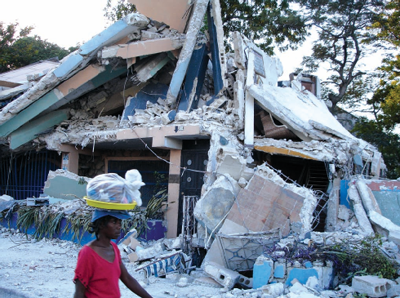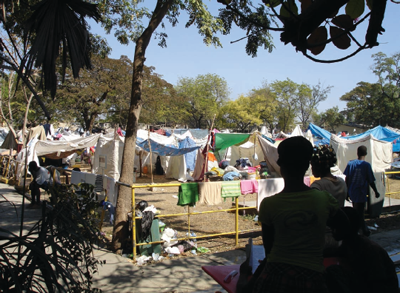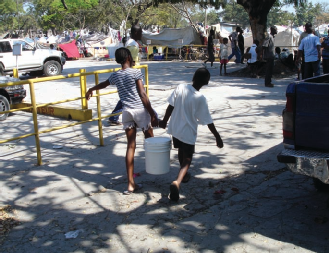Cornellians report from the front lines of the Haitian disaster
Cornellians report from the front lines of the Haitian disaster
Since a massive earthquake struck Haiti on the afternoon of January 12, images of the devastation have been beamed around the globe. But Elizabeth Fox '09 and nutrition grad student Rebecca Heidkamp witnessed it firsthand. The two were working for a nutrition program at a Cornell-affiliated clinic in Port-au-Prince; Heidkamp was training Fox, who'd been in the country all of five days. "All of a sudden there was this rumbling and the floor started moving and things started falling," recalls Heidkamp, who has lived in Haiti off and on since 2006. "We were all paralyzed, waiting for it to end, but it kept going. We just stood where we were instead of running out, which was foolish. But we were lucky— the building didn't collapse."
Before night fell, the two made their way to the townhouse complex where they lived, a walk of more than an hour. "There were buildings collapsed all around us," Heidkamp says. "The streets were full of people, everyone moving. Overall, it was shockingly calm, in that everyone was on a mission to find their loved ones—though of course there were terrible things happening all around."

Heidkamp and Fox were among the fortunate ones. Their homes were relatively intact—though they and their neighbors spent the night outdoors—and they had access to food and water. Thanks to her long tenure in Haiti and fluency in Creole, Heidkamp was able to get them on a bus to the neighboring Dominican Republic, where Fox has family; from there, Heidkamp flew back to New York City, where she spent the next several weeks helping faculty at Weill Cornell Medical College coordinate the relief effort. In mid-February she returned to Haiti for a week to help run a nutrition program for refugees, aimed at children under five and pregnant and lactating women. "It was completely devastating and tragic," she says, "to know that a place and people I love so dearly have lost so much."
The clinic Heidkamp and Fox work for, known by the French acronym GHESKIO, is an infectious disease facility geared toward the treatment of HIV and tuberculosis. Founded in the Seventies by medicine professor and Haiti native Jean Pape, MD '75, and his former faculty mentor, tropical medicine professor Warren Johnson, it has been affiliated with the Medical College ever since. The clinic has two sites: the original in the heart of Port-au-Prince and a newer facility north of the city, near the airport and the American embassy.
The earthquake left both sites damaged but functional; Pape himself suffered a minor knee injury when debris fell from the ceiling during a meeting with international health officials. In the wake of the catastrophe, GHESKIO found itself called upon not only to provide medical treatment but to tend to the thousands of refugees who took up residence on and around the clinic grounds. "Dr. Pape feels like the camp is his responsibility," says civil engineering professor Ken Hover, PhD '84, one of the many Cornell faculty who have contributed expertise to the relief effort. That has included advising Pape on such issues as how to provide sanitary facilities for thousands of refugees—in a city where the water table is too high to dig conventional latrines.

Starting a week after the quake, Hover—an authority on cement, concrete, and masonry—spent five days in Port-au-Prince, assessing the damage to the GHESKIO buildings. "Getting over there was a lesson in itself," he says. "We went in a U.S. government convoy on an absolutely traffic-choked road for twelve hours. Without the major port and the airport, you're left with a lane-and-a-half road from Santo Domingo." Hover stayed in Pape's neighborhood, in a mountainous area about an hour's drive from GHESKIO; the daily commute offered a view of the wider devastation. "Even though I had been watching CNN, I just could not comprehend it," he says. "I saw entire hillsides, entire residential communities obliterated—nothing left but rubble, entire city blocks gone. There are so many buildings in which the vertical support system failed utterly and the floors came down stacked on one another; I saw buildings in which the distance between floors was six inches or less, crushing every single thing. And every place you see a flat spot, like a city park, you see refugee tents."
'I saw entire hillsides, entire residential communities obliterated—nothing left but rubble, entire city blocks gone.'The downtown GHESKIO buildings are a maze of connected structures, some adapted from other purposes and dating from 1915; the newer campus includes a state-of-the art research center, named in honor of Johnson and dedicated just last year. All in all, Hover says, the structures held up relatively well. "In general what we observed fit the classical patterns for earthquake damage," he says. "The good news is that in every case for the GHESKIO buildings, whether the old ones or the new ones, there were no collapses or partial collapses. There remain serious questions about how much money should be spent in rehabilitating or repairing versus building new structures, but there was no loss of life." Hover is full of praise for Pape, marveling that within days the clinic was back up and running, treating patients both indoors and out, eventually in cooperation with a U.S. government field hospital that took up residence on its grounds. "Post-op is in a courtyard," Hover says. "If you're lucky you're under a tin roof, and if you're not you're under a tarp that's strung between the palm trees."

Among the other Cornell faculty who went to Haiti in the wake of the disaster was Jay Lemery, an emergency medicine professor who traveled on behalf of a Harvard-based program to assess child welfare issues. "Children were vulnerable before this," he notes, "and now they're even more vulnerable." In addition to providing a limited amount of medical treatment, such as basic first aid and wound care, Lemery and his colleagues visited dozens of sites in Haiti and the Dominican Republic, meeting with NGOs and the military and touring camps, orphanages, and hospitals. "This society, which had no reserve whatsoever, got completely sucker-punched," he says. "Haiti was one of the most destitute places in the world, certainly in the Western Hemisphere. It was a rough place before the earthquake, and whatever organizations kept it at basic levels of functioning got hit hardest, because they were the ones with the tallest buildings— which were paradoxically the weakest."
Visiting GHESKIO, Lemery says he told Pape that Weill Cornell has "a whole army of people that want to come help you." But he was suprised to learn that the major impediment to hosting volunteer health-care workers is not money or supplies but security. A prison next to the downtown clinic emptied out during the quake, and Pape has had to negotiate with gang members who have seized power in the refugee camp, in the hope of ensuring the equitable distribution of supplies. Such issues, Lemery says, are stymying the recovery effort and making an already tragic situation that much worse. "We saw huge amounts of people idle, with no economic opportunity, displaced from their homes and their families, some of them gravely injured, living in tents," Lemery says. "There's no end in sight; there's not even enough tents. And everyone's talking about the rainy season."
— Beth Saulnier
To contribute to GHESKIO's relief efforts, go to weill.cornell.edu/globalhealth or send checks, made out to "WCMC-GHESKIO," to Weill Cornell Medical College Center for Global Health, 440 East 69th Street, New York, NY 10021.


